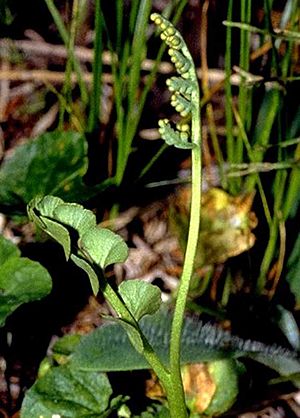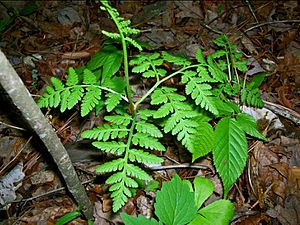Moonwort facts for kids
Quick facts for kids Moonwort |
|
|---|---|
 |
|
| Botrychium lunaria | |
| Scientific classification |
|
| Kingdom: | Plantae |
| Clade: | Tracheophytes |
| Class: | Polypodiopsida |
| Order: | Ophioglossales |
| Family: | Ophioglossaceae |
| Subfamily: | Botrychioideae |
| Genus: | Botrychium Sw. |
| Species | |
|
Several, see text |
|
Botrychium is a genus of ferns, seedless vascular plants in the family Ophioglossaceae. Botrychium species are known as moonworts. They are small, with fleshy roots, and reproduce by spores shed into the air. One part of the leaf, the trophophore, is sterile and fernlike; the other, the sporophore, is fertile and carries the clusters of sporangia or spore cases. Some species only occasionally emerge above ground and gain most of their nourishment from an association with mycorrhizal fungi.
The circumscription of Botrychium is disputed between different authors; some botanists include the genera Botrypus and Sceptridium within Botrychium, while others treat them as distinct. The latter treatment is provisionally followed here.
Contents
Selected species
Botrychium s.s., the moonworts
- Botrychium acuminatum W.H.Wagner 1990 – pointed moonwort
- Botrychium alaskense W.H.Wagner & J.R.Grant 2002 – Alaska moonwort
- Botrychium ascendens W.H.Wagner 1986 – upswept moonwort, triangle-lobed moonwort, upward-lobed moonwort
- Botrychium boreale J.Milde 1857 – northern moonwort
- Botrychium chamaeconium Bitter & Hieron. 1900
- Botrychium campestre W.H.Wagner & Farrar – prairie moonwort, prairie dunewort, Iowa moonwort
- Botrychium crenulatum W.H.Wagner 1981 – dainty moonwort, crenulate moonwort
- Botrychium daucifolium Wall. ex Hook. & Grev. 1830 – thin-leaved moonwort
- Botrychium echo W.H.Wagner 1983 – reflected grapfern
- Botrychium gallicomontanum Farrar & Johnson-Groh 1991 – Frenchman's Bluff moonwort
- Botrychium hesperium Maxon & R.T.Clausen) W.H.Wagner & Lellinger 1981 – western moonwort
- Botrychium japonicum (Prantl) Underw. 1898
- Botrychium lanceolatum (Gmel) Ångstr. 1854 – triangle moonwort, triangle grapefern, lance-leaved grapefern
- Botrychium lineare W.H.Wagner 1994 – skinny moonwort, narrowleaf grapefern
- Botrychium lunaria (L.) Sw. 1801 – common moonwort, grapefern moonwort
- Botrychium lunarioides (Michx.) Sw. 1806 – winter grapefern, prostrate grapefern
- Botrychium matricariifolium (Döll) A. Braun ex W.D.J. Koch 1847 – daisy-leaved moonwort, matricary grapefern, matricary moonwort, chamomile grapefern
- Botrychium minganense Vict. 1927 – Mingan's moonwort
- Botrychium montanum W.H.Wagner – western goblin, mountain moonwort
- Botrychium mormo W.H.Wagner 1981 – little goblin moonwort
- Botrychium neolunaria sp. nov. ined. Stensvold & Farrar 2008 – common moonwort
- Botrychium pallidum W.H.Wagner 1990 – Pale moonwort
- Botrychium paradoxum W.H.Wagner 1981 – paradox moonwort, peculiar moonwort
- Botrychium pedunculosum W.H.Wagner 1986 – stalked moonwort
- Botrychium pinnatum H. St.John – northern moonwort
- Botrychium pseudopinnatum W.H.Wagner 1990 – false northwestern moonwort, false daisy-leaved grapefern
- Botrychium pumicola Coville ex Underw. 1900 – pumice moonwort, pumice grape-fern
- Botrychium simplex E.Hitchc. 1823 – least moonwort, little grapefern, least grapefern
- Botrychium socorrense W.H.Wagner 1989 – Isla Socorro moonwort
- Botrychium spathulatum W.H.Wagner 1990 – spatulate moonwort, spoon-leaved moonwort
- Botrychium tunux Stensvold & Farrar 2002 – moosewort
- Botrychium × watertonense W.H.Wagner [hesperium × paradoxum] – Waterton grapefern
- Botrychium yaaxudakeit Stensvold & Farrar 2002 – giant moonwort, Yakutat moonwort
Botrychium species placed in Botrypus
The rattlesnake fern has traditionally been placed in the Botrychium subgenus Osmundopteris, the name of which is based on the species' superficial similarities to the genus Osmunda where it was previously placed.
- Botrychium virginianum (L.) Sw. 1801 – Rattlesnake fern, common grapefern
= Botrypus virginianus (L.) Michx. 1803
Botrychium species placed in Sceptridium
These species (the evergreen grapeferns) have traditionally been placed in the Botrychium subgenus Sceptridium,a name based on the apparent similarity of their sporangia to "little scepters."
- Botrychium australe R.Br. 1810 – Parsley Fern
- = Sceptridium australe (R.Br.) Lyon 1905
- Botrychium biforme Colenso 1886 – Fine-leaved parsley fern
- = Sceptridium biforme (Colenso) Lyon 1905
- Botrychium biternatum (Savigny) Underw. 1896 – Sparse-lobed grapefern, Southern grapefern
- = Osmunda biternata Savigny 1798
- = Sceptridium biternatum (Savigny) Lyon 1905
- Botrychium dissectum Sprengel 1804 – Dissected grapefern or Cut-leaved grape-fern
- = Botrychium obliquum Muhl. 1810
- = Sceptridium dissectum (Spreng.) Lyon 1905
- Botrychium jenmanii Underw. 1900 – Alabama grapefern
- = Sceptridium jenmanii (Underw.) Lyon 1905
- = Botrychium alabamense Maxon 1906
- = Sceptridium alabamense (Maxon) Holub. 1973
- Botrychium multifidum (S.G. Gmel.) Rupr. 1859 – Leather grapefern
- = Osmunda multifida S.G. Gmel. 1768
- = Botrychium silaifolium C.Presl 1825
- = Botrychium matricariae (Schrank) Spreng. 1827
- = Sceptridium multifidum (S.G.Gmel.) Nishida ex Tagawa 1958
- Botrychium oneidense (Gilbert) House 1905 – Blunt-lobed grapefern
- = Sceptridium oneidense (Gilbert) Holub 1998
- Botrychium rugulosum W.H.Wagner 1982 – St. Lawrence grape fern, Rugulose grape fern, Ternate grape fern
- = Botrychium ternatum auct. non (Thunb.) Sw. 1801
- = Sceptridium rugulosum (W.H.Wagner) Skoda & Holub 1996
- Botrychium schaffneri Underw. 1903 –
- Botrychium subbifoliatum Brack. 1854 – Island grapefern
= Sceptridium subbifoliatum (Brack.) Lyon 1905 - Botrychium underwoodianum Maxon 1905
- = Botrychium ternatum (Thunb.) Sw. 1801
- = Sceptridium underwoodianum (Maxon) Lyon 1905
Conservation
Moonworts can be found in many environments, including prairies, forests, and mountains. While some Botrychium species are quite rare, conservation efforts can be difficult. Determining the rarity of a species is complicated by the plants’ small leaves, which stand only 2-10 centimeters above the soil. Even more of a challenge in obtaining an accurate population count is the genus’s largely subterranean life cycle. The vast majority of any one population of moonworts actually exists below ground in banks consisting of several types of propagules. One type of propagule is the ungerminated spores, which must percolate through the soil beyond the reach of light in order to germinate. This presumably increases the probability that the spore will be in range of a mycorrhizal symbiont before it produces the tiny, roughly heart-shaped gametophyte, which also exists entirely below ground. Finally, some species produce gemmae, a form of asexual propagation achieved by budding of the root.
Juvenile and dormant sporophytes can also be hidden in the soil for long periods of time. Mature sporophytes do not necessarily produce a leaf annually; they can remain viable underground for up to 10 years without putting up a photosynthetic component. This feat is made possible by their dependence on symbiotic partnership with AM fungi of the genus Glomus, which supply most fixed carbon for growth and reproduction.
This mycorrhizal dependence has also made lab cultivation of moonworts difficult. Thus far, only germination of the gametophyte has been successful.
See also
 In Spanish: Botrychium para niños
In Spanish: Botrychium para niños



